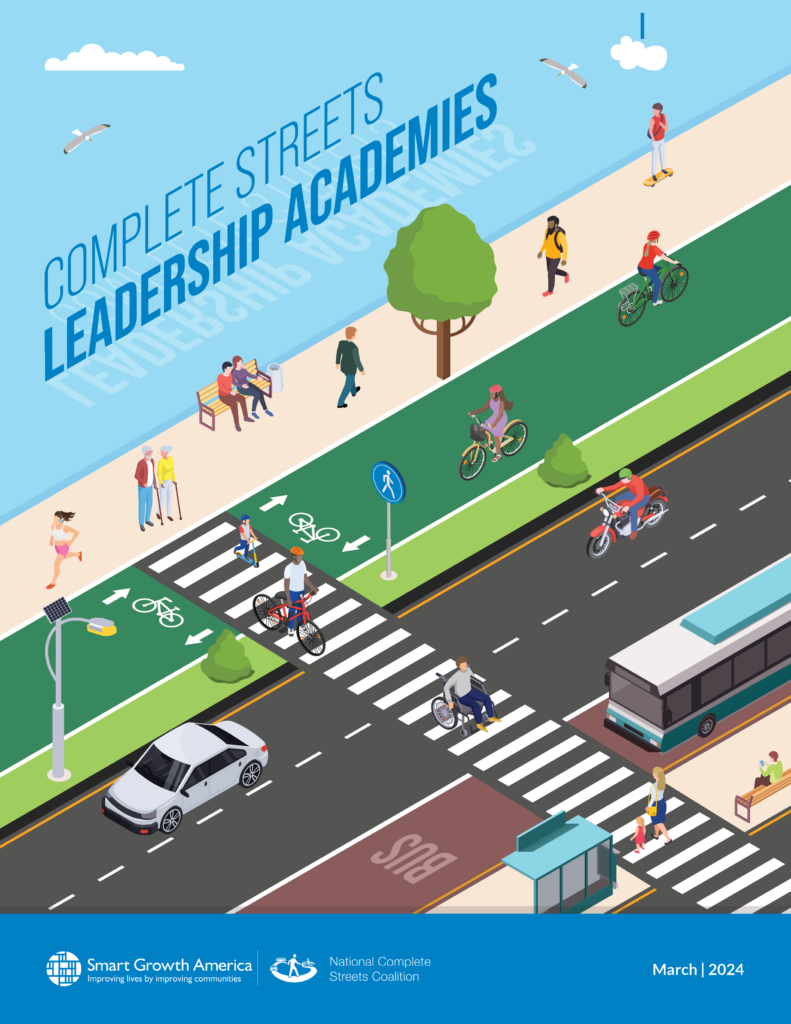With the goal of putting their 2023 Complete Streets Initiative Master Plan into action, Middletown joined the Complete Streets Leadership Academy to design and deploy a quick-build project that would improve nighttime visibility for pedestrians. Despite early setbacks, the team from Middletown was able to pivot and successfully implement a quick build that informed future efforts in the community. Read the full case study in the Complete Streets Leadership Academies Report and explore the other case studies here.
Project Snapshot
 One contributor to the national pedestrian safety crisis is the lack of visibility of pedestrians, with almost 6,000 pedestrian deaths happening when it is dark outside. Middletown sought to address this by installing pedestrian-level crosswalk lighting at the signalized intersection of Grand Street and Main Street. The location sees significant numbers of people walking as it is near multiple restaurants and other amenities.
One contributor to the national pedestrian safety crisis is the lack of visibility of pedestrians, with almost 6,000 pedestrian deaths happening when it is dark outside. Middletown sought to address this by installing pedestrian-level crosswalk lighting at the signalized intersection of Grand Street and Main Street. The location sees significant numbers of people walking as it is near multiple restaurants and other amenities.
This was not the first idea Middletown came up with for their project. Middletown initially planned to create back-in-only parking on Main Street by changing the angle of the parking spaces. However, when a local newspaper heard about the project and wrote an article on it, public opposition grew and the team realized that the constraints of the academy program did not allow time for the necessary engagement to build community support. Quickly, Middletown shifted to address concerns over pedestrian visibility and opted to explore lighting improvements to an intersection on Main Street. The pivot away from parking took staff time and resources and delayed progress on the ultimate installation.
Outcomes
The impact of the project was measured through observations, data collection, and engagement. Interviews on the ground were conducted and people noted that it was more comfortable to walk with the lighting installed. Businesses, law enforcement, and other community members also noted that it improved visibility and some inquired whether it would be made permanent.
The city felt the experience was positive overall. Middletown hopes that the effort can be replicated at other locations with minimal investment now that it has been done once before.
Key Takeaways
Expect the unexpected. Proposed projects may encounter unexpected reactions from the community or other external variables. Be flexible, creative, and open to change. Middletown’s original project idea received opposition before it was even solidified. The city then decided to pivot and come up with a project that was achievable and impactful.
Make a project that fits. Quick-build demonstrations can have a positive impact on a community without being overly ambitious. Exploring possibilities that are within budget, timeframes, and resources can still lead to permanent solutions in the future.
 In 2022, Smart Growth America launched the Complete Streets Leadership Academies in Alaska, California, Connecticut, and Tennessee to equip and train local agencies and state departments of transportation to collaborate, innovate, and commit to making changes together to address safety on these dangerous state-owned roads. Cohorts were selected to plan and implement “quick-build” demonstration projects, a way to pilot and test new ideas and street designs to activate streets and better support walking, biking, and rolling.
In 2022, Smart Growth America launched the Complete Streets Leadership Academies in Alaska, California, Connecticut, and Tennessee to equip and train local agencies and state departments of transportation to collaborate, innovate, and commit to making changes together to address safety on these dangerous state-owned roads. Cohorts were selected to plan and implement “quick-build” demonstration projects, a way to pilot and test new ideas and street designs to activate streets and better support walking, biking, and rolling.This program and report was developed with funding from the Centers for Disease Control and Prevention’s (CDC) Division of Nutrition, Physical Activity, and Obesity (Cooperative Agreement CDC-RFA-OT18-1802). The views presented in this product do not necessarily reflect the views and/or positions of CDC.